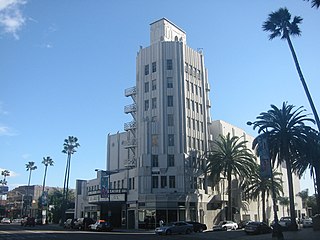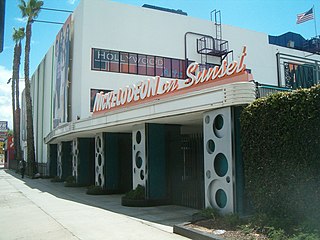
The Los Angeles County Museum of Art (LACMA) is an art museum located on Wilshire Boulevard in the Miracle Mile vicinity of Los Angeles. LACMA is on Museum Row, adjacent to the La Brea Tar Pits.

Miracle Mile is a neighborhood in the city of Los Angeles, California.

Streamline Moderne is an international style of Art Deco architecture and design that emerged in the 1930s. It was inspired by aerodynamic design. Streamline architecture emphasized curving forms, long horizontal lines, and sometimes nautical elements. In industrial design, it was used in railroad locomotives, telephones, toasters, buses, appliances, and other devices to give the impression of sleekness and modernity.

El Capitan Theatre is a fully restored movie palace at 6838 Hollywood Blvd. in Hollywood. The theater and adjacent Hollywood Masonic Temple is owned by The Walt Disney Company and serves as the venue for a majority of the Walt Disney Studios' film premieres.

Wilshire Boulevard is a 15.83 miles (25.48 km) boulevard in the Los Angeles area of Southern California, extending from Ocean Avenue in the city of Santa Monica east to Grand Avenue in the Financial District of downtown Los Angeles. One of the principal east-west arterial roads of Los Angeles, it is also one of the major city streets through the city of Beverly Hills. Wilshire Boulevard runs roughly parallel with Santa Monica Boulevard from Santa Monica to the west boundary of Beverly Hills. From the east boundary it runs a block south of Sixth Street to its terminus.

The Saban Theatre is a historic theatre in Beverly Hills, California, formerly known as the Fox Wilshire Theater. It is an Art Deco structure at the southeast corner of Wilshire Boulevard and Hamilton Drive designed by architect S. Charles Lee and is considered a classic Los Angeles landmark. The building was listed on the National Register of Historic Places on April 3, 2012.

The Pellissier Building and adjoining Wiltern Theatre is a 12-story, 155-foot (47 m) Art Deco landmark at the corner of Wilshire Boulevard and Western Avenue in Los Angeles, California. The entire complex is commonly referred to as the Wiltern Center. Clad in a blue-green glazed architectural terra-cotta tile and situated diagonal to the street corner, the complex is considered one of the finest examples of Art Deco architecture in the United States. The Wiltern building is owned privately, and the Wiltern Theatre is operated by Live Nation's Los Angeles division.

Stiles Oliver Clements was an architect practicing in Los Angeles and Southern California.

Highland Avenue is a north/south road in Los Angeles. It is a major thoroughfare that runs from Cahuenga Boulevard and the US 101 Freeway in Hollywood from the north end to Olympic Boulevard in Mid-City Los Angeles on the south end. Highland then is a small residential street from Olympic Boulevard south to Adams Boulevard. For through access, Highland swerves west into Edgewood Place which accesses La Brea Avenue.

The El Rey Theatre is a live music venue in the Miracle Mile area of the Mid-Wilshire region in Los Angeles, California.
Claud W. Beelman, sometimes known as Claude Beelman, was an American architect who designed many examples of Beaux-Arts, Art Deco, and Streamline Moderne style buildings. Many of his buildings are listed on the National Register of Historic Places.

The Academy Museum of Motion Pictures is a museum in Los Angeles, California being constructed by the Academy of Motion Picture Arts and Sciences (AMPAS), which will be devoted to the history, science, and cultural impact of the film industry. It will be the first large-scale museum of its kind in the United States. The museum will be located in the historic May Company Building on the intersection Wilshire Boulevard and Fairfax Avenue, part of Museum Row on the Miracle Mile.

San Pedro Municipal Ferry Building is a former Los Angeles Harbor Department ferry terminal building located at Sixth Street at Harbor Boulevard in the community of San Pedro in Los Angeles, California.

The Earl Carroll Theatre was a historic stage facility located at 6230 Sunset Boulevard in Hollywood, California. It was built by showman Earl Carroll and designed in the Streamline Moderne style by architect Gordon Kaufmann in 1938. The theatre has been known by a number of names since, including Moulin Rouge from 1953 to 1964 and the Aquarius Theater in the 1960s and 1970s. From 1997 to 2017, it was officially known as Nickelodeon on Sunset, housing the West Coast production of live-action original series produced for the Nickelodeon cable channel.

Walker & Eisen (1919−1941) was an architectural partnership of architects Albert R. Walker and Percy A. Eisen in Los Angeles, California.

The Westlake Theatre is a historic theater located in the Westlake section of Los Angeles, California, United States, adjacent to MacArthur Park. The theater was listed on the National Register of Historic Places in 2009.

Wilshire/Fairfax is an under-construction heavy-rail subway station in the LA Metro system in LA's Miracle Mile area along Wilshire Boulevard. It is slated to open in 2023. It will be served by the D Line and will be the second station west of Wilshire/Western station.

The Blackstone Building is a 1916 structure located at 901 South Broadway in Los Angeles, California. It has been listed as a Los Angeles Historic-Cultural Monument since 2003. The Blackstone Department Store Building is an early example of the work of John B. Parkinson, Los Angeles’ preeminent architect of the early 20th century, who also designed Bullocks Wilshire. The building is clad in gray terra cotta and styled in the Beaux Arts school.
Chapman Plaza is a building located between West Sixth Street and Alexandria Avenue in Los Angeles, California. The historic plaza building is about 50,000 square feet and is located in the heart of Koreatown, hosting several restaurants, bars, and cafes. The address is 3465 W 6th St, Los Angeles, CA 90020.

7th Street is a street in Los Angeles, California running from S. Norton Ave in Mid-Wilshire through Downtown Los Angeles. It goes all the way to the eastern city limits at Indiana Ave., and the border between Boyle Heights, Los Angeles and East Los Angeles.





















